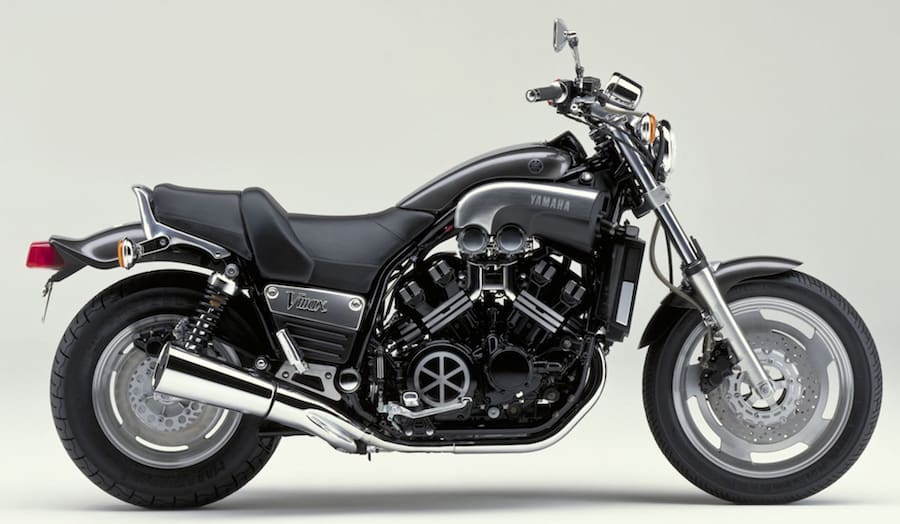It’s the Hammer’s looks that drew me to it. While I was checking out the full range of Victory motorcycles at a bike show a few years ago, I kept coming back to the Hammer. Its styling cleverly combines competing elements – the lovely flowing old-school ‘streamlined’ look with brutish hardware like the monster V-twin motor, the massive chrome exhausts and the super-wide 250mm back tyre.
The air-cooled, 1731cc, 50-degree, V-twin powerplant totally dominates the available space under the fuel tank in the tubular steel frame. Modern with electronic fuel injection, and breathing through twin 45mm throttle bodies, it’s also a good old-fashioned undersquare design (bore and stroke are 101 x 108mm). Those are the vital dimensions of a serious torque-pump. And it does what it says on the tin – torque comes on strong from 2000rpm, maxing out at 153Nm at 2900 rpm. Spin it up to 5000rpm and you access its max power of 71.3kW (97hp) on the way to the 5500rpm redline.
The gearbox is a six-speeder with the top cog being a true overdrive.
Suspension is provided by an inverted 43mm fork up front and a pre-load adjustable monoshock at rear. Braking is handled by a pair of 300mm front discs with four-piston calipers and a single 300mm rear disc with two-piston caliper mounted on cast wheels.
Aboard the Hammer the ergonomic combination sits most riders in a fairly upright posture in a comfortable enough seat whose shape locks you in position. The pillion seat comfort factor? Not so much.
You view the world from behind wide bars over a pair of easy to read analogue clocks. While the bike is obviously big and looks big, it seems less so once you’re aboard, thanks to its low 673mm seat height and the slenderness of the chassis. With much of its 303kg dry-weight set low, its size and mass don’t hinder low-speed manoeuvres; the wide rear tyre does though, tending to keep the bike upright at walking pace. You soon learn to master it.
Clutch action is reasonably light and progressive. Throttle response is nice, with efficient and well-sorted fuelling under all conditions and super-linear power delivery. The more you twist the throttle, the more you get. And there’s plenty on offer.
Gear-changing is unexpectedly precise for a heavy-duty cruiser transmission. Engine and gearbox are happiest when you short-shift, building speed very rapidly as you surf the bike’s mountainous wave of torque.
It’s best to avoid sixth gear until you reach 110km/h where the engine picks up the drive happily at just under 2500rpm. At highway speeds the Hammer offers a creditable safe touring range of over 250km from the 17-litre tank.
Braking performance is strong, with a progressive response from the front discs. The harder you squeeze, the quicker it slows. The back brake is less progressive, being inclined to lock up a bit too readily.
The Hammer handles well thanks to its firm-riding suspension, producing its best results on smooth surfaces. The wide handlebars give you full authority over the bike, enabling you to shove it into bends at speed, despite the combined reluctance of the raked out front end and the wide rear tyre. Maintaining some force on the inside ’bar keeps the bike on lean and on line through turns taken at speed. Footpeg cornering clearance is reasonable by cruiser standards. The effect of mid-corner bumps is magnified by the firm suspension and the rear tyre’s width. But wrestling this beast through a bit of rough stuff produces its own pleasure.
If you’re seriously into the authentic American muscle-bike experience the Victory Hammer deserves a high place on your short list. The now-extinct brand from the Polaris factory is a showcase for the company’s excellence in engineering, build quality and overall on-road dynamics.
WHAT TO LOOK FOR
These big Victory muscle cruisers are rugged, pretty much bullet-proof machines.
Inspect paintwork and plating carefully for signs of neglect or damage – snazzy looks are central to the cruiser-owning experience.
As always adjust your offer to cover worn consumables like tyres, steering-head bearings and brake pads and rotors – and in particular a drive belt approaching the end of its 48,000km service life.
The ideal prospect is a medium-kays example with good service records if possible.
SERVICE HISTORY
Capable DIY owners will find it relatively easy to carry out routine servicing on their Victory Hammers. These big nakeds offer good access to many service items. The maintenance-free hydraulic valve lifters make the task easier. A bit of specialist help is advisable for fuel injection and engine management issues.
The basic service interval is 8000km for oil and filter changes. Pre-2011 Hammers, however, require servicing at 4000km intervals. Service life for the drive-belt is 48,000km.
Building Bricks
Here are the bikes that mark the evolution of the Victory Hammer S

1985 –Yamaha V-Max pioneers a new from-dragstrip-to-street motorcycle category that came to be known as ‘muscle cruisers’.

2001 – Harley-Davidson’s V-Rod shows that the Milwaukee factory was ready to join the fray with its own muscle cruiser.

2004 – Triumph’s Rocket III, a 2.3-litre monster, demonstrates that the Brits are also serious about the muscle cruiser category.
Price Guide
New Price
$30,995(2009)
$23,995(2017)
Second-Hand
$12,900– $22,600
WORDS ROB BLACKBOURN
PHOTOGRAPHY AMCN ARCHIVes











